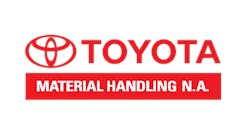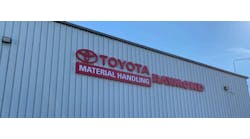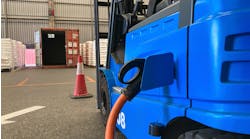Lift trucks and their operators have two things in common: There are fewer of them working these days, and those that are working are doing a wider variety of tasks.
With the operators, multi-tasking is a matter of cross-training. With lift trucks, it's often a matter of finding the right attachments — and attaching them quickly. The less operators have to think about the process of attaching attachments, the better. That's what lift truck OEMs and attachment makers are thinking about these days. In fact they're partnering more so that their respective devices will be better partners with each other.
“Although the equipment gets put together at the dealer, in the customer's eyes it's really one piece of equipment and we have to be in as much lock step as we can,” says J. B. Mayes, manager of product strategy for internal combustion products at Nacco Material Handling Group (NMHG). “The primary interface entails how it fits on the carriage, the hydraulics and how you control it. We have to make sure we're optimizing the hydraulic spec for that attachment so when the customer gets that unit, the truck and attachment are working as efficiently as possible.”
Truck/Attachment Crosstalk
Because companies have cut back on operators and lift trucks, they need all the efficiency they can muster. If they're going to rely on a single lift truck for several types of applications in their facility, they need quick-change attachments, even attachments that can communicate timely information to the lift truck. OEMs are looking at opportunities to use the Controller Area Network (CAN bus) to accomplish that. David Land, manager of design engineering for Toyota Industrial Equipment Mfg., Inc., sees an opportunity to integrate CAN bus on attachments and send control signals indicating hydraulic pressures, wear data or number of clamp cycles.
“In the not-too-distant future technology that's integrated into the attachment will be able to communicate with the lift truck, the operator and warehouse management systems,” Land says. “Information such as product ID, product weight, dimensions and pick locations will all be available from the attachment to allow the operator and the lift truck to operate more efficiently than they do today.”
Scales integrated into the attachment will be able to send product weight to the operator as well as wirelessly to a central system. Land believes that capability will become a popular option throughout the industry as markets understand the benefit of knowing the weight of a load.
“The lift truck might also begin to use that information as part of an integrated stability system,” he says. “The stability of a lift truck changes as the load changes. Beyond that, radio frequency identification (RFID) also has a huge potential as an add-on.”
So does radio frequency communication. For example, Cascade offers RF control as an option with some of its sideshifters. This not only eliminates hard wiring, but it permits the use of a single auxiliary valve to control both sideshift and fork positioning functions.
Power Sharing
Mayes wants to see the day when attachments come equipped with their own hydraulic systems and don't need to tap into the lift truck's hydraulics. That kind of “attachment friendliness” is also leading to attachment-ready lift trucks that operate as if they were designed specifically for an application. For example, some companies are asking their lift truck dealers for multi-load handling attachments to speed up trailer loading and unloading. Because the lift truck is handling two loads side by side versus only one load, the operator is twice as efficient.
Until attachments come with their own power sources, lift truck makers are making it easier for them to tap into theirs. For example, Rick Woerter, sales engineer for The Raymond Corporation, notes that an attachment can tap into the AC power of the lift motor. If the lift truck uses a lift motor that is not AC-powered, the attachment can still be controlled with software that spins the pump at a predetermined speed to provide the energy required for the attachment's application. Woerter says this energy can be easily adjusted to give the specific amount required to make the attachment work at its maximum potential.
Handling Challenges
With all the technological advancements being applied to lift trucks and their attachments, you can't override the laws of physics. The fundamentals will always apply. Layer picker attachments provide a useful example. When these were introduced to the beverage industry a few years ago, their productivity attracted a big following. However, the repeated clamping action required a beefier lift truck specification due to the higher amount of stress placed on the vehicle.
Woerter describes how some Raymond customers use its three-wheel stand-up counterbalanced lift truck with such an attachment. With the inventory at floor level, similar to a very narrow aisle (VNA) application but without a rack, the operator travels back and forth in the aisle and picks layers of a product at a time. The operator then brings the picked layer to the end of the aisle to build a stacked load to fill a customer order.
Lift truck attachments also contribute to more efficient transportation. Don Bratton, a partner with BEB Industrial Asset Management, Kansas City, Mo., points out that in the construction industry, for example, pipe, lumber and plywood loaded onto flatbed trailers must be covered with tarps. Tarping fees add to the cost of transportation. However, with curtain-sided trailers, lift trucks equipped with sideshifters, turn-a-loads and invert-a-loads can make better use of the trailer cube by positioning product to fit the format. He offers the drywall industry as another example.
“In the drywall industry they used to have a very expensive crane on the back of a flatbed so when the driver got to his destination, he would use that crane to set the load where the customer wanted it,” he says. “That worked OK, but with all the variations of sites, they soon developed a forklift that is an attachment to the flatbed. It's called a piggyback, and now they don't have to buy that expensive crane. The piggyback offers more flexibility because it can go anywhere on the job site.”
As attachment and lift truck innovations continue to be developed, their manufacturers will have to collaborate even more closely than before to ensure a good match at the end user site. Make sure you're part of that collaboration. Tell them your productivity benchmarks and your company's plans for growth. Your plans will drive their plans for developing an attachment to your business.


